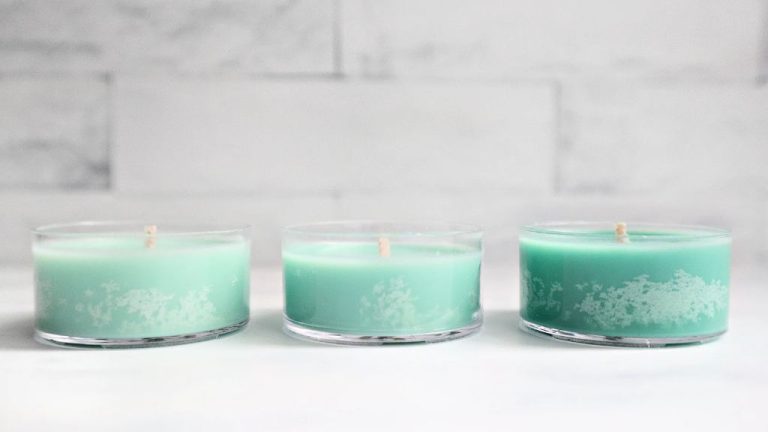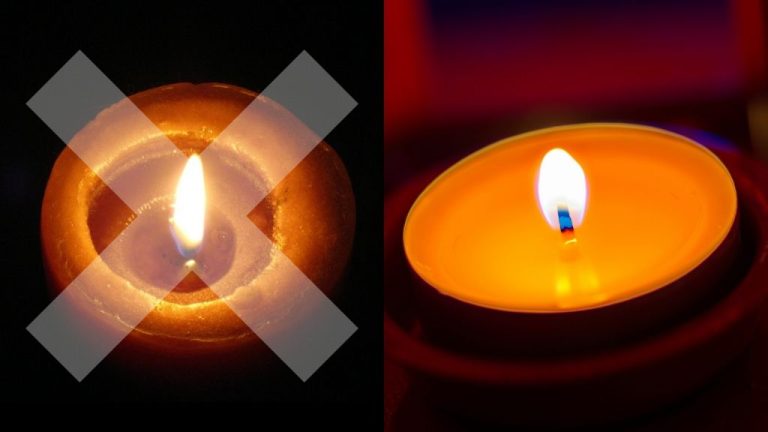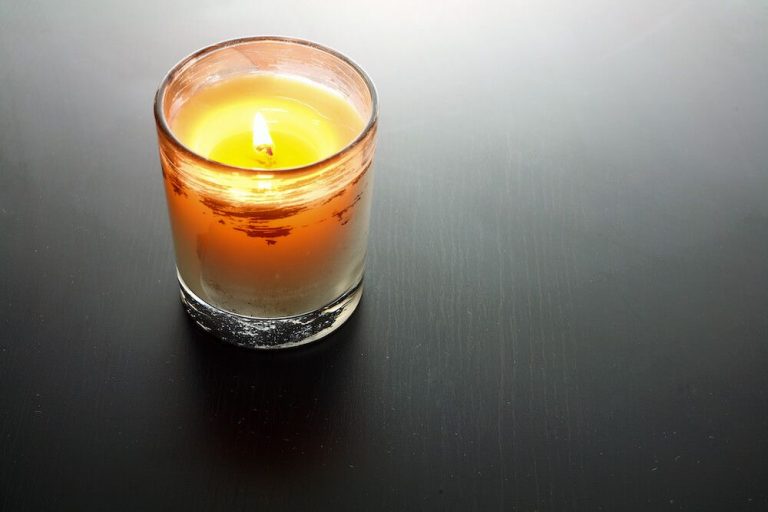When A Candle Turns Black What Does It Mean?
When burning a candle, it’s common to notice black soot forming on the candle glass or wax. This soot, also called carbon, is created from incomplete combustion of the candle wax. Specifically, black soot occurs when the candle wax does not burn fully and produces more smoke and carbon.
Black soot can be an indication that the candle is not burning optimally. While small amounts may occur naturally, excessive soot buildup can create safety hazards, ruin the look of a candle, and be a nuisance to clean up. Understanding what causes black soot allows candle users to adjust their habits and materials when needed to achieve proper, clean candle burning.
Normal Candle Burning Process
When a candle burns normally and cleanly, the flame melts the nearby wax which is then drawn up the wick by capillary action. The heat of the flame vaporizes the liquid wax, which is then combusted by the flame. This normal burning creates a bright yellow flame and minimal to no smoke or soot residue.
Proper wick sizing and trimming is key for clean candle burning. According to CandleScience.org, “When a candle burns, the flame heats the nearby air and starts to rise. As this warm air moves up, cooler air and oxygen rush in at the bottom of the flame to replace it” https://candles.org/candle-science/. Wicks that are trimmed to the proper height allow for enough oxygen flow to enable full combustion of the wax vapor.
Causes of Black Soot
Black soot on candles is often caused by having a wick that is too long. As the candle burns down, the wick gets longer and is unable to properly draw up and melt the wax. This leads to the wick producing more soot rather than burning cleanly. Keeping wicks trimmed to 1⁄4 inch can help reduce soot from overly long wicks (https://aluminatelife.com/what-is-candle-soot-how-to-get-rid-of-it).

Another cause of black soot is low quality wax. Paraffin wax that contains impurities or additives can clog wicks and prevent them from burning properly. This incomplete combustion results in more soot. Using wax that is purer and free of dyes or fragrances can minimize sooting issues from poor quality wax (https://www.harlemcandlecompany.com/blogs/journal/why-do-some-candle-jars-turn-black).
Candles that have high, uncontrolled flames also tend to produce more soot. Large flames that flicker and dance produce inefficient combustion and billowing smoke. Maintaining the proper flame height for the candle size and keeping it shielded from drafts will yield a lower, steady flame that burns cleaner (https://aluminatelife.com/what-is-candle-soot-how-to-get-rid-of-it).
Wick Trimming
One of the most common causes of black soot on candle wicks is having a wick that is too long. Trimming the wick helps reduce sooting by creating a smaller, cooler flame that burns the wax more efficiently. As the National Candle Association notes, “Candles should be burned within the manufacturer’s recommended burn time. Longer burn times can cause excessive melting of wax which affects performance” (Source). Keeping the wick trimmed to 1⁄4 inch before lighting prevents the wick from becoming too large as the candle burns. Using a wick trimmer allows for a quick, clean cut each time.
Trimming the wick also removes any existing black soot, giving the candle a fresh start. It’s recommended to trim the wick between each use to maintain optimal flame size and prevent future sooting issues. A short wick that curls over as it burns is a sign that the wick needs to be trimmed before the next use (Source). Keeping the wick trimmed throughout a candle’s life can help minimize soot and extend the candle’s burn time.
Wax Quality
The type of wax used in candle making can impact how likely a candle is to produce black soot. According to Candle Science & Testing (https://candles.org/wp-content/uploads/2020/05/Summary-of-07-Okometric-study-on-candle-wax-emissions.pdf), natural waxes like beeswax and soy wax tend to burn cleaner and are less likely to soot compared to paraffin wax. This is because natural waxes have a different chemical composition that results in more complete combustion. Paraffin wax contains some impurities that can lead to the production of black carbon particles.
When making candles, choosing a high-quality natural beeswax or soy wax from a reputable supplier can help minimize sooting issues. Properly wicked candles made from beeswax or soy tend to burn with a brighter, steadier flame that consumes the wax and wick more efficiently. This cleaner burn results in less black soot.
Flame Size
One of the most common causes of black soot is letting the candle flame burn too high or too large. According to Harlem Candle Company, the maximum safe flame height for most indoor candles is 3 inches. When a candle flame burns taller than this, it can produce much more black soot.
A large, tall flame provides more heat to melt the wax and pull up the wick. This allows more wax vapors to escape and react with oxygen, producing the soot particles that make the flame appear black and release black smoke. Studies using imaging techniques have shown higher soot concentrations in larger candle flames, especially those over 3 inches high. Verdugo et al. (2020) found strong correlations between wick diameter, flame size, and total soot volume.
To prevent excess soot, it is recommended to trim the wick before each use to maintain a smaller flame height around 1-3 inches tall. The flame should not extend over the edges of the candle or container. A flame that is too high provides an early warning sign to trim the wick or extinguish the candle to avoid excessive soot.
Ventilation
Proper ventilation is key to preventing black soot when burning candles. As the candle burns, smoke and soot are released into the air. Without adequate airflow, these particles can build up in the room and deposit on surfaces like walls, furniture, and even HVAC vents (https://beyerairconditioningheating.com/how-candles-affect-indoor-air-quality/).
Soot is attracted to cooler surfaces due to thermophoresis. This can lead to black residue accumulating on walls, especially over studs, and on HVAC supply vents as the ventilation system recirculates sooty air (https://www.freshairducts.com/hidden-dangers-in-candles).
To prevent smoke buildup, make sure the room has sufficient ventilation. Open windows and doors to create cross breezes. Avoid burning candles in small, enclosed spaces. Use fans to circulate air. Proper airflow will whisk away smoke and soot, preventing black residue on surfaces.
Candle Holder
The candle holder can have an effect on soot production for a few reasons. Certain materials like glass or metal can get very hot while the candle is burning, which speeds up melting and affects airflow (Bfactory, 2022). Additionally, the shape and size of the holder impacts how well air can circulate and oxygen can reach the flame. A properly sized holder that allows adequate airflow can help reduce sooting.
Deep holders or large jars tend to trap more heat and impede air movement, while more open holders like pedestals or plates allow better airflow. Materials that stay cooler like wood, ceramics, or heat-resistant metals are preferable. Make sure the holder keeps the candle upright and stable as well, since tilting can cause the flame to smoke and produce more soot.
Safety Concerns
Black soot accumulating on a candle or in the air indicates the candle is not burning optimally. Soot is composed of unburned carbon particles and is the result of incomplete combustion when burning a candle. Significant amounts of soot can present some safety risks. According to The New York Times, candle soot contains trace amounts of toxins like formaldehyde and acetaldehyde. Large amounts of soot emissions over time could potentially pose health risks, especially for people with respiratory issues.
However, experts say the minuscule amounts of soot produced by most properly burning candles do not significantly impact indoor air quality or human health. The safety risks are very low if you trim wicks regularly and allow candles to burn in a well-ventilated area. But allowing excessive soot to accumulate indoors without proper ventilation can increase potential hazards. Overall, some soot production is normal, but large amounts of black smoke and soot are signs the candle needs to be extinguished and the wick trimmed for optimal safety.
When to Trim or Extinguish
There are a few signs that indicate it’s time to trim the wick or extinguish the flame to prevent black soot from accumulating:
The wick becomes too long, generally longer than 1/4 inch. This makes the flame too big and produce more soot. Trim the wick down to 1/4 inch to reduce sooting.
The flame starts to smoke and produces black smoke. This is a sign the candle isn’t burning cleanly and will create black soot. Trim the wick or extinguish the flame.
The melted wax pool edges start to climb up the side of the jar. This is called mushrooming and indicates the flame is too large. Trim the wick down to reduce the flame size.
Black soot starts accumulating on the candle jar. Once soot builds up, it can be difficult to remove. Extinguish the candle and clean off any soot before relighting.
The flame flickers and jumps wildly. This unstable flame will produce more soot. Trim the wick or extinguish the candle until the wax fully liquefies again.
You start to see black smoke stains on your walls or ceiling. The sooty smoke indicates the candle isn’t burning properly. Immediately extinguish the candle and address the sooting issue before relighting.
“Signs like an overly long wick, sputtering flame, and black smoke are cues to adjust the candle to prevent excess soot production,” said Lisa Johnson, owner of Candle Creations [1].





